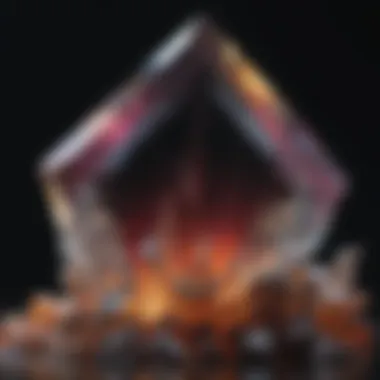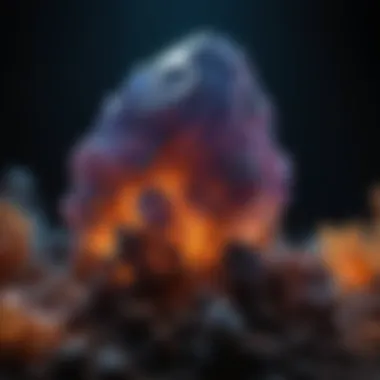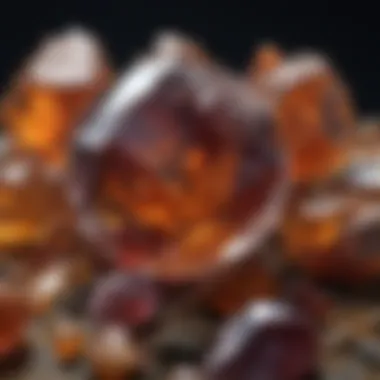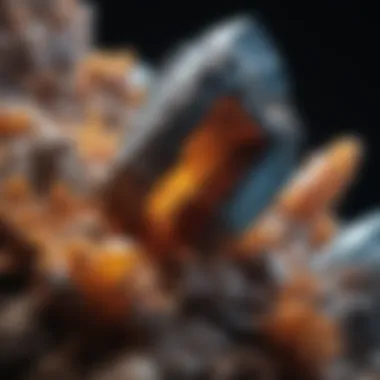Unveiling the World of Fine Mineral Specimens: A Collector's Definitive Guide


Rock and Fossil Identification
When delving into the world of fine mineral specimens, understanding rock and fossil identification is paramount. Different types of rocks and fossils possess unique characteristics that can be observed and appreciated by avid collectors. Whether it's the intricate patterns in agates or the fossilized remains of ancient creatures, each specimen holds a story waiting to be uncovered. To aid in the identification process, collectors rely on a range of tools such as magnifying glasses, scratch tools, and UV lights to reveal hidden details.
Collecting Tips and Techniques
For enthusiasts looking to expand their collections, mastering collecting tips and techniques is essential. Best practices include researching prime collecting sites known for their diverse mineral offerings. Proper planning and preparation are crucial when embarking on a collecting trip to ensure a safe and successful excavation of specimens. Learning how to safely extract specimens without causing damage requires delicate handling and the use of specialized tools.
Preservation and Display
Preserving and displaying mineral specimens is an art form in itself. Techniques for preserving rocks and fossils involve cleaning, stabilizing, and protecting fragile specimens from environmental degradation. Proper storage methods, such as using acid-free archival boxes and humidity-controlled cabinets, help maintain the integrity of the collection. When it comes to creative display ideas, collectors have the opportunity to showcase their treasures in aesthetically pleasing arrangements that highlight the uniqueness of each specimen.
Geological Insights
Exploring fine mineral specimens provides valuable insights into geological formations and processes that have shaped the Earth over millennia. From the formation of crystals within geodes to the imprint of marine life in sedimentary rocks, each specimen offers a window into the Earth's history. Understanding the historical significance of rocks and fossils sheds light on past ecosystems and evolutionary changes. Notable discoveries in the field continue to expand our knowledge of the Earth's geology and the fascinating array of mineral specimens waiting to be uncovered.
Introduction to Fine Mineral Specimens
In the realm of mineral collecting, understanding the nuances of fine mineral specimens is paramount. This section serves as a foundational pillar in our exploration of this intricate world. Fine mineral specimens hold a unique allure, beckoning collectors with their beauty and scientific significance. By delving into their multifaceted nature, enthusiasts gain a deeper appreciation for the earth's treasures.
Definition and Significance
The Beauty of Mineral Specimens
The beauty inherent in mineral specimens transcends mere aesthetics; it embodies a profound connection to our planet's geological history. Each mineral's distinctive color, luster, and formations tell a story of millennia in the making, captivating collectors and geologists alike. The allure of mineral beauty lies not only in its visual appeal but also in the promise of unraveling Earth's mysteries through their crystalline structures.
Their Scientific and Aesthetic Value
Beyond their aesthetic appeal, fine mineral specimens hold immense scientific value. These crystalline wonders provide insights into geological processes, mineral formation, and even environmental conditions. With a fusion of scientific rigor and artistic beauty, mineral specimens offer a harmonious blend that fosters appreciation for both realms. Their dual significance enriches the collecting experience, making each specimen a treasure trove of knowledge and beauty.
Historical Overview
Early Discoveries and Collections
The narrative of fine mineral collecting is intricately woven with tales of early explorers unearthing nature's hidden gems. From the mineralogical pioneers of centuries past to the intrepid collectors of today, each discovery adds a chapter to the evolving saga of mineralogy. Early collections laid the foundation for our modern understanding of minerals, paving the way for scientific inquiry and aesthetic appreciation.
Impact on Mineralogy and Geology
The impact of mineral specimens on the fields of mineralogy and geology cannot be overstated. These crystalline marvels serve as windows into Earth's geological processes, offering tangible evidence of its immense geological history. Through diligent study and preservation, mineral collectors contribute to the advancement of mineralogical knowledge, enriching our comprehension of the planet's rocky tapestry.


Role in Modern Collecting
Trends in Contemporary Mineral Specimen Collecting
In the digital age, mineral collecting has witnessed a resurgence, fueled by online communities and accessible resources. Modern collectors not only seek rare specimens but also engage in knowledge exchange and collaborative efforts. The evolving trends in collecting reflect a deepening passion for Earth's treasures, transcending mere acquisition to encompass a holistic appreciation for minerals' geological and aesthetic intricacies.
Market Dynamics and Popular Specimens
The dynamic nature of the mineral market mirrors the complex interplay of supply, demand, and collector preferences. From coveted gemstones to sought-after crystal formations, market dynamics dictate trends and values in the mineral collecting sphere. Understanding the market forces that shape popular specimens is key to navigating the world of fine mineral collecting, ensuring a well-informed and discerning approach to building a mineral collection.
Identifying and Classifying Minerals
In the realm of fine mineral specimens, the ability to accurately identify and classify minerals holds paramount importance. This section serves as a cornerstone in the comprehensive guide, offering collectors invaluable insights into the characteristics and categorization of various minerals. By understanding the physical and chemical properties unique to each mineral species, collectors can enhance their expertise and appreciation for these geological treasures.
Physical Properties
Color, Luster, and Crystal Form
Exploring the physical properties of minerals unveils a realm of intricacies that define their allure. The vibrant hues, surface reflections (luster), and geometric structures (crystal form) play pivotal roles in both scientific identification and aesthetic appreciation. By delving into the nuances of color variations, types of luster, and diverse crystal forms, collectors gain a deeper understanding of mineral diversity and rarity.
Hardness, Cleavage, and Specific Gravity
Another crucial aspect of mineral classification lies in assessing hardness, cleavage patterns, and specific gravity. The ability to determine a mineral's resistance to scratching (hardness), tendency to break along specific planes (cleavage), and density compared to water (specific gravity) aids in accurate identification and differentiation. These properties not only reveal unique characteristics but also assist in discerning between similar-looking specimens, enhancing the precision of a collector's observations.
Chemical Composition
Elements and Compounds in Minerals
The chemical composition of minerals forms the foundation for their distinct properties and behaviors. Exploring the presence of elemental components and compound structures within minerals unveils a world of diversity and complexity. By focusing on the composition of minerals, collectors gain insights into their origins, formation processes, and potential interplay with other elements in their natural environments.
Importance of Chemical Analysis
Chemical analysis stands as a critical tool in mineral classification and understanding. By emphasizing the significance of chemical analysis, collectors equip themselves with the means to delve beyond external appearances and uncover the intrinsic components that define each mineral specimen. This analytical approach not only deepens appreciation but also facilitates more accurate identifications and classifications.
Classification Systems
Strunz, Dana, and Other Mineral Classification Schemes
Navigating the intricacies of mineral classification systems such as Strunz and Dana offers collectors a systematic way to categorize and organize specimens based on their structural characteristics. By exploring these established classification schemes, collectors streamline their identification processes and gain a structured framework for cataloging their collections. Understanding the nuances of mineral classification systems enhances precision and knowledge within the collecting community.


Taxonomy and Nomenclature of Mineral Species
The taxonomy and nomenclature of mineral species play a crucial role in standardizing naming conventions and classifying minerals based on their shared attributes. Delving into the taxonomy of mineral species allows collectors to uncover the evolutionary relationships between different specimens and discern the underlying principles governing mineral classification. By grasping the nuances of mineral nomenclature, collectors enrich their understanding of geological history and mineralogical classifications.
Collecting and Preserving Techniques
In the realm of fine mineral specimen collecting, mastering the art of collecting and preserving techniques is paramount to maintaining the integrity and beauty of precious finds. This article delves deep into the methodologies and strategies essential for enthusiasts looking to expand their collections with quality specimens. By delving into the intricacies of collecting and preserving techniques, readers gain a more profound understanding of the processes involved in acquiring and safeguarding these geological treasures.
Field Collection
Tools and equipment for mineral hunting:
The selection of the right tools and equipment for mineral hunting is a critical aspect of successful field collection expeditions. This article sheds light on the importance of choosing the appropriate tools that can enhance the effectiveness of mineral hunting endeavors. Exploring the varied features and functions of tools such as rock hammers, chisels, and magnifying glasses, readers are equipped with the knowledge needed to navigate geological terrains with precision and accuracy. Understanding the specific characteristics of each tool aids collectors in optimizing their fieldwork and increasing the likelihood of uncovering unique mineral specimens. Additionally, insights into the advantages and disadvantages of different equipment further contribute to maximizing the efficiency of field collection processes.
Ethical considerations and legal aspects:
Ethical considerations and legal aspects play a key role in the responsible practice of field collection in the world of mineral specimen collecting. This section delves into the ethical implications of mineral hunting, emphasizing the importance of respecting natural habitats and adhering to legal guidelines. By highlighting the significance of ethical conduct when engaging in field collection activities, collectors are encouraged to prioritize conservation efforts and sustainable practices. Exploring the nuances of ethical considerations and legal compliance adds a layer of depth to the overall field collection experience, fostering a sense of environmental consciousness and responsibility among enthusiasts.
Storage and Display
Proper containers and preservation methods:
The proper storage and preservation of fine mineral specimens are essential aspects of maintaining their quality and longevity. This segment provides an in-depth analysis of the significance of utilizing appropriate containers and preservation techniques to safeguard valuable specimens. By discussing the key characteristics of ideal storage containers and preservation methods, readers gain valuable insights into the best practices for mitigating damage and degradation. Understanding the unique features of different preservation approaches equips collectors with the necessary tools to ensure the preservation of their prized mineral specimens effectively.
Creating aesthetically pleasing displays:
Creating visually appealing displays is a crucial component of showcasing fine mineral specimens in all their glory. This section explores the art of crafting aesthetically pleasing displays that not only highlight the beauty of the specimens but also engage viewers on a visual level. By emphasizing the key characteristics of display aesthetics and the benefits of thoughtful presentation, collectors can elevate the viewing experience for themselves and others. Delving into the unique features of creative display techniques offers readers inspiration and insight into curating captivating showcases that accentuate the allure of fine minerals.
Cleaning and Maintenance
Safe cleaning techniques for mineral specimens:
Maintaining the cleanliness of mineral specimens without compromising their integrity requires the application of safe cleaning techniques. This section addresses the significance of employing the right methods to clean mineral specimens effectively. By exploring the key characteristics of safe cleaning techniques and their benefits in preserving the specimens' visual appeal and value, collectors gain a deeper understanding of proper maintenance practices. Moreover, the discussion of unique features of safe cleaning methods enables readers to discern the most suitable approaches for enhancing the cleanliness and overall aesthetics of their mineral collections.
Preventive care and conservation practices:
Preventive care and conservation practices play a crucial role in ensuring the long-term sustainability of fine mineral specimens. This segment illuminates the importance of adopting proactive measures to prevent damage and deterioration of specimens over time. By highlighting the key characteristics of preventive care and conservation practices and elucidating their benefits in mitigating environmental threats, collectors are empowered to safeguard their collections for future generations. Exploring the unique features of conservation techniques provides readers with a comprehensive overview of the strategies that can enhance the longevity and beauty of their prized mineral specimens.
Popular Fine Mineral Specimens


In the realm of fine mineral specimens, understanding the significance and allure of popular varieties holds paramount importance. Popular fine mineral specimens not only showcase the beauty of nature but also serve as prime examples of geological wonders. Within this article, the exploration of popular mineral specimens delves into the intricacies of quartz varieties, gemstones, crystals, as well as rare and unusual finds. Each specimen offers a unique story of formation, rarity, and visual appeal that captivates collectors and enthusiasts alike. By delving into the world of popular mineral specimens, collectors can gain a deeper appreciation for the vast array of treasures our planet has to offer.
Quartz Varieties
Quartz varieties play a pivotal role in the appreciation of fine mineral specimens. Amethyst, citrine, and rose quartz stand out among the diverse range of quartz varieties, each boasting distinct characteristics that add to their allure. Amethyst's rich purple hues, citrine's vibrant yellow tones, and rose quartz's soft pink coloration mesmerize collectors with their beauty. These quartz varieties not only exhibit stunning visual appeal but also hold metaphysical properties that appeal to crystal enthusiasts. Their availability in nature, coupled with their aesthetic qualities, makes them sought-after choices for mineral collectors worldwide. However, each quartz variety presents unique characteristics and considerations that collectors must navigate to fully appreciate their value and beauty.
Amethyst, Citrine, and Rose Quartz
Amethyst, citrine, and rose quartz represent a trio of quartz varieties that symbolize beauty and elegance in the world of minerals. Amethyst's regal purple hue exudes a sense of tranquility and spiritual connection, making it a favored choice among enthusiasts seeking inner peace and balance. Citrine, with its sunny yellow brilliance, embodies warmth and positivity, attracting collectors drawn to its energizing qualities and abundance. At the same time, rose quartz's gentle pink hues radiate love and compassion, making it a popular choice for those seeking emotional healing and harmony. These quartz varieties not only offer visual delight but also serve as sources of inspiration and energy for individuals exploring the metaphysical aspects of minerals.
Quartz Inclusions and Special Formations
Within the realm of quartz specimens, the presence of unique inclusions and special formations adds an extra layer of fascination for collectors. Quartz inclusions, such as rutiles, chlorites, or iron oxides, create mesmerizing patterns and textures within the crystalline structure, enhancing the visual appeal and uniqueness of the specimens. Special formations, such as scepters, enhydros, or phantom crystals, showcase the geological history and intricate growth stages of quartz, providing collectors with valuable insights into the mineral's formation processes. These distinct features not only make quartz specimens aesthetically appealing but also highlight the diversity and complexity of nature's artistic creations, making them prized additions to any fine mineral collection.
Ethical Considerations and Community Engagement
In the realm of exploring fine mineral specimens, the topic of Ethical Considerations and Community Engagement stands as a vital pillar guiding collectors towards responsible practices and positive interaction with the community. Imbued with a sense of environmental consciousness and social responsibility, this facet of mineral specimen collecting transcends mere acquisition to foster sustainable relationships and practices within the collecting community. By shedding light on the ethical dimensions of collecting, this article seeks to elevate the discourse surrounding fine mineral specimens and encourage a culture of conscientious collecting.
Sustainable Collecting Practices
Respecting natural habitats and protected areas
Respecting natural habitats and protected areas emerges as a cornerstone principle in the ethical framework of mineral specimen collecting. This commitment to preserving ecosystems and honoring biodiversity underscores the significance of responsible stewardship in the pursuit of mineral specimens. By adhering to ethical principles governing land use and conservation, collectors play a pivotal role in safeguarding natural resources and maintaining ecological balance. The meticulous care extended towards protecting these vulnerable environments not only upholds the intrinsic value of minerals but also ensures the sustainability of future collecting endeavors. Understanding the delicate interplay between human activity and the natural world motivates collectors to prioritize ethical considerations, fostering a harmonious relationship between their passion for specimens and environmental preservation.
Supporting conservation efforts and ethical sourcing
Engagement in conservation efforts and a commitment to ethical sourcing represents a proactive stance towards ensuring the longevity of fine mineral specimen collecting. By aligning with initiatives dedicated to safeguarding endangered species and habitats, collectors actively contribute to the preservation of Earth's natural heritage. Embracing sustainable practices in sourcing specimens not only bolsters ethical integrity but also fortifies the ethical foundation of the collecting community. Ethical sourcing practices underscore a conscientious approach to acquiring specimens, promoting transparency and accountability throughout the collecting process. Emphasizing the importance of supporting conservation programs and advocating for ethical sourcing reinforces the ethical imperative underpinning the fine mineral specimen collecting, fostering a culture of respect and environmental mindfulness within the community.
Participating in Mineral Shows and Exchanges
Networking with fellow collectors and experts
Networking with fellow collectors and experts engenders a sense of camaraderie and shared enthusiasm within the fine mineral specimen collecting community. The exchange of knowledge, experiences, and insights among collectors cultivates a collaborative spirit that enriches the collecting journey for individuals at all levels of expertise. By engaging in networking activities, collectors not only broaden their understanding of minerals but also forge meaningful connections that transcend geographic boundaries. The collaborative atmosphere characterizing mineral shows and exchanges serves as a catalyst for learning, innovation, and enrichment, fostering a sense of belonging and mutual support within the community of collectors.
Trading, selling, and sharing knowledge
The practice of trading, selling, and sharing knowledge encapsulates the essence of reciprocity and shared discovery within the fine mineral specimen collecting landscape. Through the exchange of specimens, collectors participate in a dynamic ecosystem of acquisition and dissemination, where the circulation of minerals not only fulfills individual collecting goals but also contributes to the collective wealth of knowledge within the community. Trading and selling minerals serve as avenues for expanding collections, while knowledge sharing promotes continuous learning and scholarship among collectors. This collaborative ethos underpinning the exchange of minerals and information cultivates a vibrant and interconnected community bound by a shared passion for fine mineral specimens.
Contributing to Research and Education
Collaborating with scientific institutions
Collaborating with scientific institutions heralds a synergistic alliance between collectors and academic establishments, precipitating advancements in mineralogical research and education. By fostering collaborative partnerships with research entities, collectors facilitate the exchange of expertise, resources, and data that enrich the scientific understanding of minerals and geological processes. Through these collaborations, collectors actively contribute to the expansion of knowledge in the field of mineralogy, propelling research endeavors and discoveries in uncharted territories. The intersection of collecting and scientific inquiry not only broadens the scope of mineralogical studies but also nurtures a culture of inquiry and exploration, bridging the gap between enthusiasts and experts in the pursuit of shared learning and discovery.
Promoting interest in geology and mineralogy
Promoting interest in geology and mineralogy constitutes a cornerstone initiative in igniting curiosity and fostering a deeper appreciation for the Earth's geological wonders. By championing the dissemination of geological knowledge and advocating for the study of mineral specimens, collectors play an instrumental role in nurturing a new generation of geology enthusiasts and burgeoning scientists. Encouraging public engagement with rocks, minerals, and fossils, collectors inspire a sense of wonder and inquiry that transcends age and background, fostering a diverse community of geology enthusiasts. The promotion of interest in geology and mineralogy not only enriches educational outreach initiatives but also propels the preservation of Earth's geological heritage, forging a legacy of appreciation and stewardship for future generations to inherit.







